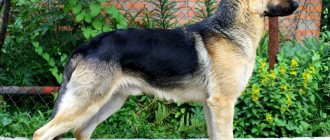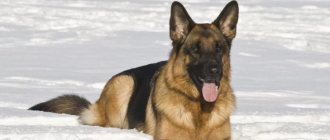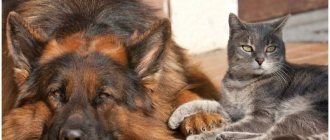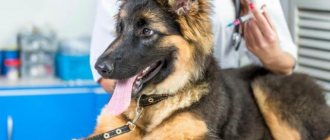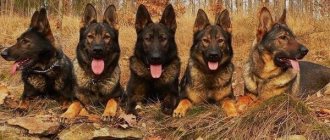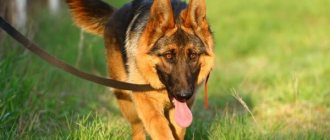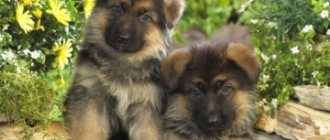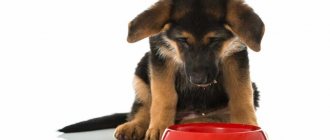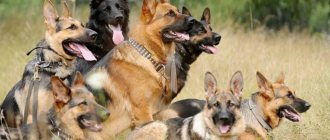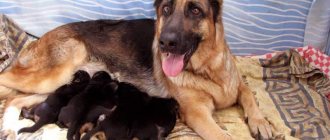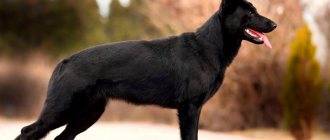| Breed name | East European Shepherd |
| Breed name in English | East European Shepherd |
| Country of origin | Russia |
| Type | Large dog |
| Weight | 30-60 kilograms |
| Height (height at withers) | 62-76 centimeters |
| Color | Black with various markings |
| Wool length | Shorthair |
| Lifespan | 10-12 years |
| Character | Obedient, balanced, confident, alert, intelligent |
| Number of puppies (average) | 5-10 |
| Price of puppies | 50-400$ |
- 9.1 For a boy
Description
The East European Shepherd is a working breed that was bred in the Soviet Union. The species was created by crossing German Shepherds and indigenous Russian breeds such as the Laika. The breeders wanted the individuals to be adapted to the frosty temperatures of Russia. The East European Shepherd is known for its guarding abilities, intimidating black appearance and high devotion to its owner.
Distinctive features
The East European Shepherd is included in group 1 of the RKF classification . One of the main features of the East European Shepherd is its size, since the trophy German dogs that were used to breed this breed were originally taller representatives.
Main characteristics of the exterior:
- The head is large, proportional, wedge-shaped. The frontal part is round, wide, the transition to the muzzle is smooth.
- The ears are medium-sized, pointed, triangular, directed slightly upward and forward, erect, set high and wide, with little hair. They stand up by about a year.
- The bridge of the nose is smooth, sometimes a hump is possible (not a defect).
- The muzzle is long, with a faint furrow.
- The nose is rectangular.
- The nose is black.
- The nostrils are large, open, and black.
- The eyes are medium-sized, oval, set slantwise, color – shades of dark brown, amber.
- The eyelids are dense, dry, and completely hide the whites of the eyes.
- The lips are dark, moderately thick, dry, and fit tightly to the muzzle.
- The teeth are white and strong. The standard implies 42 teeth, including incisors and canines.
- bite .
- The cheekbones are rounded.
- The jaws are well developed.
- The coat is of medium length, close to the body, the hair is hard; The undercoat is thick and light in color.
- The withers are pronounced.
- The neck is oval.
- The body is powerful, strong, heavy. The muscles are clearly defined.
- The limbs are strong, sinewy, smooth, the joints are strictly parallel to the body, the paw pads are black.
- Color: Black (solid) black, against a background of light fawn or gray to black shade of the main color. Possible red shades, the presence of white spots in the chest area (undesirable signs).
- The tail is saber-shaped and carried low in its natural position.
Appearance
— Advertising —
According to the standard, the parameters of individuals are as follows:
| Parameter | Male | Bitch |
| Height at withers | 66-76 cm | 62-72 cm |
| Weight | 35-60 kg | 30-50 kg |
The head is moderate in size, elongated and in proportion to the rest of the body. When viewed from the front, the forehead and upper part of the skull are flat and never convex. Head without excess skin and wrinkles.
The eyes are medium-sized, oval or almond-shaped, slightly slanted. The eyes are light to dark brown in color, with black, pigmented edging.
The ears are medium in size, straight, set high on the skull. The ears are never long, excessively large, rounded or folded.
— Advertising —
The muzzle is full, deep and wide. The upper and lower jaws are well developed, approximately equal in length, and never look weak.
The nose is large, pigmented and black. The nostrils are open. The nose is level with the vertical line of the end of the muzzle, or may extend a little further.
The neck is muscular and of moderate length, which allows the dog to wear its head proudly. It gradually tapers from the wide body to the head. There is no excess skin on her.
The chest is long, well defined, deep. The forechest is well developed, not too convex.
The body is muscular. The width at the front is approximately equal to the width at the back.
Paws from oval to round; with convex toes, black pads and nails. The toes are webbed for swimming.
The tail is thick at the base and tapers towards the tip. It may be straight or slightly curved at the tip.
Basically, the species has a black body color. It has light brown markings on its face, tail, belly, legs, and sometimes on its sides, back, and neck. Individuals also come in blue, light blue and yellow-brown colors. Sometimes there are animals of silver, sable, red, solid white and agouti (gray and red) colors. In Russia and Ukraine, two types of colorings called zonal and laundry are common.
Photos of the animals are presented below.
Colors
The East European Shepherd's coat should be well pigmented - this is a sign of the dog's health.
Zonar is characterized by a distribution of several shades: light at the root, brown and gray in the middle, and black at the tip. The coat looks pockmarked, with a grayish tint.
The breed is characterized by a saddleback color - a combination of a light tone and a black mask.
According to the standard, the following shades are acceptable:
- light gray;
- pale yellow;
- grey;
- zonal red color;
- black.
A dog's coat may have red or tan areas, but a solid color is not allowed by the standard.
Pros and cons of a dog
Pros of the type:
- Animals can learn any commands quickly enough, as they have high intelligence.
- Dogs are capable of performing various types of work: being watchmen, hunters, serving in the army and police.
- Pets are energetic.
- It will not be difficult for you to take care of the species. You rarely need to bathe the animal, and this will be easy to do, since most animals love water.
- Dogs are faithful. Therefore, soldiers can easily trust them to handle serious tasks, including search and rescue and security.
- Animals have an attractive appearance.
- Pets adapt well to any weather.
- Owners will have all the necessary information about caring for the dog due to the popularity of the species.
Disadvantages of the type:
- The downside is that the animals shed a lot. This occurs especially intensively in spring and autumn. You should be prepared to use the vacuum cleaner frequently in your home.
- Dogs should not be left alone for a long time. They may develop destructive behavior and aggression due to boredom.
- Pets may bark too loudly, disturbing you and your neighbors.
- They are suspicious of strangers. Dogs will only feel comfortable in the presence of their owner.
- Germans can sometimes think that they are the dominant individual in the family, which can make them difficult to raise.
- The animals are energetic and large in size. Due to this, it is difficult for them to live in small apartments.
Reviews
Elena Krasina: Many people are surprised how such a serious dog gets along in a house with children. In fact, our Baikal is a calm, intelligent and good-natured dog. He understands perfectly who his family is and who needs to be protected. We always feel safe because we have invested time and effort into raising him.
Oleg Ryabin: I have been the owner of a shepherd dog for several years, and I can’t imagine another breed nearby. I have known the breed since my service days. Loyal and obedient dogs, and most importantly, excellent helpers.
Evgenia Zotova: My relatives kept Oriental Shepherds all their lives, and each one was like a family member to us. I can't imagine a more loyal dog. For me, shepherd dogs will always be the smartest and most beautiful breed.
The Eastern Shepherd is suitable for any owner, be it a housewife with many children or a single traveler. This breed is for those who are looking for smart and loyal pets, but do not want to deal with the disadvantages of exotic dogs.
History of the origin of the breed
The history of the East European Shepherd begins with the First World War. Before it began, Russia was considered one of the most powerful empires on Earth. During the fighting, the forces of the Russian Empire were easily defeated by the German army. Although the German army had many technological and organizational advantages, the Russians were most noticed by the German military dogs. Until this moment, the Slavs almost did not use dogs in the army. They used dogs only for hunting and herding livestock. Most of the species available to them were not trained enough to be used effectively during combat.
The German Empire used a number of specially bred, highly trained specimens, including the standard schnauzer, boxer, doberman and pinscher. The German Shepherd was the most impressive of them all. It was created by Max von Stephanitz in the late 1800s. The versatile, controllable and highly skilled pet proved useful to the German military. He also made a great impression on the Kaiser's opponents.
During the war, thousands of German dogs traveled throughout the country now known as the Republic of Belarus. It was under German occupation for most of the conflict. The locals fell in love with these animals, so they took them in during and after the war. The Belarusians began to breed individuals, although they did not keep the animals clean, like their German colleagues.
In addition, the Soviet military leadership sought to create new types of dogs that could serve as working animals for the new world power. Since most of these people had recently fought against the Nazis, the shepherd made a strong impression on them. Unfortunately, the breed proved unable to work in most of the Soviet Union. It is very cold in Germany, especially in the mountains of Bavaria, where the ancestors of the German Shepherd were bred. But even there there are no such sharp temperatures as are found in regions such as Karelia, Siberia, Mongolia and Kamchatka. Many individuals either died out or became so cold that they could no longer do their job.
Despite the above restrictions, the breed was well known in other parts of the USSR. Where she survived by the end of the 1920s. Initially, the species was called the “Belarusian Shepherd Dog” due to its popularity in Belarus.
As devastating as the First World War was for the Russian Empire and its people, the Second World War turned out to be incalculably worse. The conflict had a great impact on the development of the Belarusian Shepherd Dog. As a result of the conflict, there was great interest in developing a new type of military dog. State-sponsored breeding efforts were carried out at a high level. They were led by the Soviet military and secret police (KGB). They bred a dog that was very similar to the German Shepherd, but with strong influences from the Laika breed.
The development of the breed was largely completed by the end of the 1940s. By this point, it was widespread throughout the Soviet Union. The animal became known as the East European Shepherd.
By 1964, the Canine Council of the Soviet Union published an official standard for the purebred species, and pedigrees began to be preserved.
The animal became one of the most commonly used working species in the Soviet Union. It has also gained popularity as a private guard dog. The popularity of the East European Shepherd grew steadily until the late 1980s and early 1990s. However, the prevalence decreased significantly after the fall of communism.
Eased border restrictions have allowed more foreign dogs to enter the regions. Many of them were considered more desirable by Soviet residents.
The East European Shepherd began to be constantly crossed with other dogs. Therefore, every day there are fewer and fewer purebred purebred individuals left.
Despite the fact that the species is widespread, its numbers continue to decrease every year. This pet is still used by the Russian, Ukrainian and Belarusian militaries, as well as the armed forces of several Central Asian republics.
Maintenance and care
Care
The animal's fur is thick. Although she will not require professional grooming, her coat will need to be brushed at least twice a week. More frequent brushing may be needed during shedding, which occurs in spring and fall.
Periodically, trim your pet's nails if they do not wear down naturally. Do this at home or at a groomer.
Brush your teeth at least 2 or 3 times a week. Check and clean your pet's eyes and ears once a week if necessary.
Exercises
This is an energetic dog, so it will need a lot of daily exercise. A long walk may not be enough for this active individual. Give your pet additional activities, such as chasing a ball. Without enough exercise, your dog will develop behavioral problems that include aggression.
You should take your pet to the vet for checkups about once a year. The specialist should also draw up a vaccination schedule for the animal.
Nutrition
Many owners wonder: what to feed East European Shepherds?
The best food for a species is one that meets macronutrient requirements, provides all essential vitamins, minerals, and contains only safe ingredients.
Unfortunately, choosing food today is not so easy. There are many options, and some of them are not very good. The feed industry is not strictly regulated. This means that some brands even contain potentially harmful ingredients.
A few things to consider when choosing food:
- Optimal amount of nutrients. Selecting a feed with the correct distribution of nutritional components is vital. You should strive to select the best combination of biologically significant elements specifically for that breed. The diet of the species should be something like this:
- Protein content of at least 18%. It is necessary to replenish energy reserves and build all body tissues.
- Fat content of at least 5%: Fats meet the dog's high energy requirements and also improve its health.
- Fiber: Natural fiber supports healthy digestion as well as your dog's weight.
- Vitamin C: Supports joint health, preventing problems such as hip dysplasia and arthritis.
- Grain-free food. Many dog owners believe that grain-free food is of high quality. However, it is not. It often does not contain more meat than grain-based foods. Instead, companies simply remove grain ingredients from their regular formula and replace them with low-quality vegetables, such as peas.
- Avoid fillers. Unscrupulous manufacturers add fillers to their feed. They do this to make their product cheaper.
- Quality ingredients. First, avoid fillers, as mentioned earlier. And secondly, the sources of meat and other ingredients must be of high quality. Do not buy brands that do not indicate what specific meat the food is made from. Often, the "meat by-products" in the ingredients are not a good choice either, as they are not nutritious at all or are made from rotten raw materials.
Dogs need a lot of calories. For example, an adult needs 1700-2100 calories per day. Feed 2 times a day.
Mature dogs that are already 8 years old are susceptible to obesity. Therefore, you should not continue to feed them foods that are high in protein and fat. However, if your pet exercises and exercises regularly, an overall moderate diet with all ingredients is also considered healthy. A senior pet needs about 1,200 calories per day. They can be fed 2 times a day.
Nutritional requirements of older animals:
- Extra vitamins and minerals: These will keep your bones and joints in good condition.
- Fish oil: is a source of Omega 3 and 6 fatty acids. They provide an anti-inflammatory effect for older dogs.
- Fewer carbohydrates: Since older animals are highly vulnerable to obesity and diabetes, a diet with a low glycemic index is preferable for them.
Feeding
You can feed VEO with natural food or ready-made industrial feed. When using factory-made food, it is necessary to choose a line for large breeds of dogs, taking into account the age and physiological state of the animal. Many well-known companies produce separate lines for puppies, pregnant and lactating bitches, and older large breeds. The daily dosage of feed is indicated on the manufacturer's factory packaging.
When using a traditional diet, the owner must prepare food for his beloved pet himself. This method is more energy-intensive, but natural food contains more beneficial nutrients. VEO's diet when using "natural" should consist of raw beef and sea fish (30-50%), cereals (20-30%), vegetables (5-20%), fermented milk products (20-30%), offal, fruits and healthy treats.
Girl
You can distinguish a female from a male by size. However, it is important to remember that these are just averages. Sometimes there are bitches that are larger than men, and vice versa.
The height at the withers of girls is 62-72 cm, their weight is 30-50 kg.
Females mature much earlier than males. This means they will be easier to train. However, when a female dog is in heat, she can be difficult to train, especially if there are other dogs nearby.
The female dog is friendlier and has a more gentle personality. Although they may still try to achieve dominance, this does not happen as often as compared to male dogs.
Females tend to be friendlier towards strangers and children.
Boy
The height at the withers of males is 66-76 cm, its weight is 35-60 kg.
Male dogs try to dominate quite often, so if you are not assertive enough, you may find it difficult to train them.
When successfully trained, the animals make excellent watchdogs, protectors, and police officers.
Males are more easily distracted, especially when they smell a female in heat.
Males are proud and have a more dominant personality. If you don't show strong leadership, they will be more likely to try to take the initiative.
Males tend to be more aloof and wary of strangers. Unlike other dogs who jump at the chance to meet new people, German Shepherds remain calm and reserved.
They often become attached to one owner and have an extremely strong bond with him. Usually, this is the person who feeds, trains and walks the dogs.
One more thing you should take into account. Because boys are generally larger, they tend to require more food.
Nicknames
Many puppy owners think: what is the best name for their new friend? Below are the most popular names for the species.
For boy
Popular nicknames for boys:
- Maximus.
- Charlie.
- Friend.
- Jack.
- Toby.
- Duke.
- Oliver.
- Jake.
- Bentley.
- Tedy.
- Riley.
- Leo.
- Winston.
- Louis.
- Oscar.
- Cody.
- Harley.
- Gas.
- Sam.
- Bruno.
- Marley.
- Rex.
- Rocco.
For girl
Popular nicknames for girls:
- Bella.
- Lucy.
- Margarita.
- Lola.
- Maggie.
- Sophie.
- Chloe.
- Sandy.
- Dakota.
- Mini.
- Callie.
- Athena.
- Trixie.
- Jozzie.
- Katie.
- Fiona.
- Grace.
- Nina.
- Heidi.
Breeding
The first heat in girls occurs between the ages of 6 months and one year. On average, it lasts 2-4 weeks.
Have parents dewormed and vaccinated a month before mating. You need to introduce the individuals immediately before mating.
A girl's pregnancy lasts 58-65 days. Provide your bitch with a high protein diet and regular walks. In general, individuals show no signs of pregnancy in the early stages. They appear only in the 4th week.
Childbirth for girls lasts from several hours to a day. Ensure that an experienced breeder or veterinarian is present.
5-10 babies are born at a time. The average newborn weighs about 370-600 g. Month-old and even one-and-a-half month old babies are still heavily dependent on their mother's milk.
Mating
Mating dates for Eastern European dogs differ for females and males . It is not recommended to breed females earlier than 20 months , and males - earlier than 24 months . This age is optimal. As a reference point, common dog breeding practice considers the third estrus in bitches, although individual characteristics of physiological development may differ from individual to individual.
In the classic version, mating is carried out on days 11-13 from the beginning of estrous activity, in the second phase, which is called estrus or sexual heat. Special preparations for mating are not required, but the general rule is the health of the dogs. Mating is not allowed if the dog suffered an infection shortly before the intended mating, was exhausted or was overweight. For best results, examination by a veterinarian is advisable.
Mating is usually carried out in the morning, without feeding. The only condition is a good preliminary walk for both dogs, while active activities should be excluded. Typically, mating is carried out “on the territory” of the male dog, since this is where he will be able to show the highest level of sexual activity.
The time allotted for getting to know each other is from 5 to 15 minutes , and the bitch’s tail will serve as a signal for readiness for mating. As soon as she stops in place (characteristic straight stance) and takes it to the side, you need to start knitting.
The number of people who are present during mating varies from 0 to 3 and depends on the “experience” of the dogs themselves. Dogs that have mating skills most often do not need help. If one of the dogs is mated for the first time, both owners are usually present. However, if one of the owners does not have mating experience or is overly nervous, the presence of a competent instructor is advisable.
Puppies
If possible, you should meet both of the dog's parents before purchasing. This will help you determine what kind of character your pet will have when he gets older.
If you have this breed in your home, there are many things to consider when raising a pet. Having a dog is a big responsibility. Think of it like a little child. The German needs a lot of love, food and education.
The puppy has a small bladder. This means he will urinate frequently. At least once every 2-3 hours if he drinks enough water. One way to tell that your baby needs to go to the toilet is if your puppy walks in circles while sniffing the ground.
Socialize your new friend as early as possible. Introduce him to new people, places and situations.
One of the most important things when raising a pet is to make sure he sees you as a leader. If you don't show dominance, your dog probably won't listen to you.
East European Shepherd puppies are bundles of endless energy. They need a lot of calories to maintain an active lifestyle. Feeding frequency varies depending on age:
| Age | Feeding frequency |
| 2-4 months | 4 or 5 times a day |
| 4-6 m. | 3 times a day |
| 6-15 m. | 2 times a day |
Nutritional requirements for puppies:
- At least 22% protein: Protein helps in building muscle mass and strength.
- Fat 5–8%. Fats maintain healthy skin and shiny coat. It is also a vital component for brain and eye development.
- Calcium and phosphorus: essential for the development of strong bones and joints.
Dog character
Overall, the breed's temperament is a combination of a German Shepherd and a Laika.
This species is known for its loyalty and devotion. Dogs form close bonds with their owners. They tend to become attached to one person. Even when pets are raised in a family, they may ignore everyone else.
Animals generally do not form close bonds with children unless they become their sole owners. Although early socialization may help the pet adapt to toddlers, this species will not play “softer” with children than with adults.
The pet is usually suspicious of strangers. The dog will not behave aggressively overtly with proper training and socialization. But he will always be wary and remain aloof in the presence of people unknown to him.
Dogs are extremely vigilant and protect their home well.
Most dogs get along well with other dogs if they are properly trained and socialized.
This is the dominant breed. She will never obey the commands of someone she considers below her in the hierarchy. This means that owners must always show their dominance.
The East European Shepherd is a very energetic breed. This is due to the fact that she was bred for constant work. Animals should have at least an hour of vigorous exercise every day. More will only be beneficial. If your pet stays at home all the time, this can lead to destructiveness, hyperactivity, excessive excitability and aggression on his part.
The attitude of a shepherd dog to a person
European Oriental Shepherds recognize the master not as the one who feeds, but as the one who teaches. All family members can take part in the training process - the dog will treat them more respectfully.
These animals are well aware of the status of each person entering the house. Well-mannered shepherd dogs do not attack family members. Guests are treated with caution and their behavior is carefully studied.
If the person has not gained trust, the dog may react aggressively. In case of open expression of hostility towards the owners, she attacks.
VEOs get along well with children and are patient when dealing with them. Some shepherd dogs are happy to join in games, and during a walk they act as a guard.
Education and training
The dogs are extremely intelligent, athletic and eager to please their owners.
Start teaching babies at about eight months of age. Although any individual is highly trainable, they are extremely tough and powerful creatures. If you start training from the puppy stage, you have the chance to build and develop character and develop an early bond with him.
Start training your friend with basic commands. You will have to teach him to sit, stand, bark, and so on. Of course, your pet won't learn everything instantly, so be patient if your pet doesn't immediately do what you ask.
Here is an approximate sequence for training the sit command:
- Step 1: Wait for your dog to stand in front of you. Hold your favorite treat in your hand and then show it in front of your eyes and make sure he sees it. This should excite the dog and attract his attention.
- Step 2: Slowly move the hand holding the treat over the animal's head towards the back of the head. All this time, make sure that the treat remains at the level of his nose.
- Step 3: Your pet will automatically lower his hindquarters to the floor in a sitting position to maintain eye contact with his favorite treat. When his back hits the floor, give him a treat and praise him for a job well done.
- Step 4: After a few days, enter the "sit" command and continue training in the same manner.
- Step 5. Train in this manner for a few more days. If the animal does not respond, repeat the command. Do not reward your dog with treats until he responds to the command. Keep practicing until your pet won't sit even without treats.
Use food treats and praise to reinforce teams.
Avoid aggression.
Key points in training
Training Shepherds
Pets are easy to educate and train; obedience and unquestioning execution of commands are in their blood. The dog is always one step lower than the owner, since the owner is the main one in the human-dog relationship. The pet does not want to show its owner that it is smarter.
During training, the shepherd loves praise and treats as a reward. Training begins at 2 months. The key to successful parenting is consistency in activities with your pet.
At 2 months, the puppy must follow basic commands:
- "To me";
- “Ugh” or “No”;
- "Place";
- "Give me your voice."
The dog masters more complex commands in the age range from 4 to 6 months. Daily walks should be accompanied by sports exercises to overcome obstacles. Classes can also be conducted on special platforms for dogs. In the age range from 4 to 6 months, the puppy masters more complex commands:
- "Sit";
- "Lie"
- "Near";
- "Stand";
- "Give";
- "Forward".
By the 8th month of life, a new skill is revealed - to find objects. Similar classes are carried out by dog handlers. At 1 year and 6 months, the puppy should have developed all the basic skills. If the dog has easily mastered the initial course, then further training will proceed without difficulties.
Note! Consistent training with a puppy develops discipline and transforms behavior from thoughtless to productive.
Differences between German and East European Shepherds
The East European Shepherd is almost identical to the German one. Therefore, they are often confused, especially in the United States of America. However, there are a number of differences between breeds that experts are aware of. These include the larger size, thicker coat, and limited range of colors found in the Eastern European type. This breed exhibits great variability in terms of appearance. This is due to the fact that some lines of the East European Shepherd have been crossed with other species.
The main differences between the German Shepherd and the East European Shepherd:
| Characteristic | East European Shepherd | East German (German) Shepherd |
| Purpose | Working dog | Shepherd dog |
| Origin | Russia | Germany |
| Boy's height | 66-76 cm | 60-65 cm |
| Girl's height | 66-76 cm | 55-60 cm |
| Boy's weight | 30-50 kg | 29-40 kg |
| Girl's weight | 30-50 kg | 23-33 kg |
| Lifespan: | 10-12 years | 10-13 years |
| Size | Big dog | Big dog |
| Other names | Belarusian Shepherd | East German Shepherd |
| Temperament | Affectionate, aggressive, vigilant, cheerful, brave, curious, energetic, friendly, independent, intelligent, lively, loving, loyal, sociable, playful, protective, sympathetic, social, stubborn, territorial | Affectionate, aggressive, vigilant, cheerful, courageous, independent, loving, protective, social |
| Care | Moderate difficulty | Higher difficulty |
| Learning ability | Easily | Easily |
| Hypoallergenic | No | No |
| Child Friendly | No | Yes |
Table of growth dynamics of the lengths of the body, front legs and head
| Age (in months) | Oblique body length (cm) | Chest (cm) | Front paw length (cm) | Pastern girth (cm) | Head length(cm) | Muzzle length (cm) |
| 1 | 25-30 | 36-45 | 11-16 | 8-10 | 12-15 | 3-4 |
| 2 | 37-44 | 47-55 | 18-25 | 10-12 | 16-19 | 8-10 |
| 3 | 47-54 | 55-62 | 24-30 | 11-12,5 | 19,5-22 | 12-14 |
| 4 | 55-62 | 60-69 | 28-34 | 11,5-13 | 22-25 | 15-18 |
| 5 | 61-66 | 65-74 | 31-36 | 12-13,5 | 24-27 | 20-23 |
| 6 | 64-71 | 69-78 | 33-38 | 12-14 | 25-28 | 25-28 |
| 7 | 66-73 | 71-81 | 34-39 | 12-14 | 26-29 | 30-33 |
| 8 | 68-75 | 74-83 | 34,5-39,5 | 12-14 | 26,5-29,5 | 35-43 |
| 9 | 71-76 | 75-85 | 35-40 | 12-14 | 27-30 | 35-43 |
| 10 | 72-77 | 75-86 | 35-40 | 12-14 | 27-30 | 35-43 |
| 11 | 72-77 | 78-88 | 35-40 | 12-14 | 27-30 | 35-43 |
| 12 | 72-78 | 80-89 | 35-40 | 12-14 | 27-30 | 35-43 |
The table shows that the completion of the formation of different parts of the body of a dog of this breed occurs at different periods of life.
Diseases
The main health problems are associated with the large size of the species. The most common are orthopedic diseases and gastric bloating.
- Hip dysplasia. The term dysplasia means abnormal growth. Therefore, “hip dysplasia” means abnormal growth or development of the hips. What causes this disease? The disease is mainly genetic in origin and its severity will vary between animals. This is due to a variety of factors such as body weight, nutrition, hormone levels, exercise and others. It is important to note that inheriting a gene is not simple. Breeding dogs with “normal” hips can result in offspring with dysplastic thighs and vice versa. Therefore, it is important to take your young puppy to the vet for a checkup.
- Degenerative myelopathy. This is a genetic disease that causes progressive weakness, incoordination and paralysis of the hind limbs. It usually affects dogs over 5 years of age. As the name suggests, the disease causes degeneration of nerve fibers in the spinal cord and their insulating layer called “myelin.” Although these changes can occur anywhere along the spine, the area most commonly affected is the mid and lower back. Unfortunately, there are no methods for a complete cure. There is only supportive therapy that helps control the condition of animals. Responsible breeding is the only way to prevent the disease.
- Stomach bloating or volvulus. Bloat is a life-threatening condition in which the stomach is repeatedly distended. In many cases, it twists and turns, cutting off its own blood supply. The spleen is also involved, which impairs the blood supply. How can you tell if your pet has this problem? The main signs are: sudden bloating, restlessness, pain (eg, heavy breathing, the pet won't let you rub its belly), drooling, and multiple nonproductive attempts to vomit. What to do in this situation? You should take your pet to a veterinary hospital or emergency room immediately.
- Perianal fistula. The disease is characterized by draining holes in the skin around the anus. Sick pets may strain to defecate, experience diarrhea or bloody stools, and frequently lick the anal area. Sometimes an unpleasant odor appears in the place where the pet lay. This probably indicates the appearance of a secondary infection. Scientists and veterinarians have studied this process well enough that many types of treatment are now available.
- Megaesophagus. Megaesophagus (from the Greek Mega meaning "large") is a condition in which the esophagus becomes weak. In this regard, he is not able to normally pass food on the way to the stomach. This is an inherent problem. Recent research has shown that it is associated with chromosome 12. Affected dogs show signs of vomiting and belching when given solid food. Pets usually look emaciated. Often, management of the problem involves liquid diets and increased feeding frequency, but this may vary depending on the individual patient. There is no “cure” for this disease.
- Pancreatitis. The pancreas constantly secretes enzymes that are designed to facilitate digestion. In a healthy individual, these enzymes are not activated until they reach their intended destination - the small intestine. However, in animals with pancreatitis, these enzymes are activated earlier than necessary. This leads to inflammation, which damages the pancreas and other organs. Early signs of pancreatitis are usually not noticeable. However, you should be aware of the most common symptoms of the disease: abdominal pain, loss of appetite, diarrhea, high fever, lethargy, nausea, vomiting, weakness. Mild pancreatitis can be treated with rest and a low-fat diet. In more serious cases, surgery may be required.
- Urinary tract infections. These are the most common infectious diseases in dogs, regardless of breed. They can occur for various reasons. Most often, they are caused by bacteria that enter the urinary tract through their genitals. Main symptoms: bloody urine, cloudy urine, pain or discomfort when urinating, genital sensitivity, incontinence, high fever. Be sure to contact a specialist who will prescribe tests and appropriate treatment.
Interesting Facts
- East European Shepherds had great merit during the Second World War. A monument to this breed was erected in Moscow, which symbolizes all front-line dogs.
- The pet, named Julbas, found more than 7,000 pieces of ammunition during World War II and was even awarded the Medal of Merit.
- An animal named Elga took part in the Chechen War. The dog saved many Russian soldiers from death, as he detected enemy mines in time.
- The founder of the East European Shepherd breed was named Abrek. He is known for his participation in the film "Gaichi", which was released in 1938.
- Films in which the breed participated: “Give me a paw, friend” (1967), “Come to me, Mukhtar” (1964), “Border dog Scarlet” (1979), “Honor of the Uniform” (2008), “This is mine dog" (2012), "This is my dog 2" (2015).
- One of the most popular films about dogs in the Soviet Union is “Come to Me, Mukhtar.” In the film, a dog named Sultan helped the main character find stolen jewelry. Their cost was about 300 thousand rubles.
- You need to be careful with unfamiliar East European Shepherd dogs. They have a great bite force.
- They are excellent swimmers, so they can easily catch up with a criminal even in the water.
